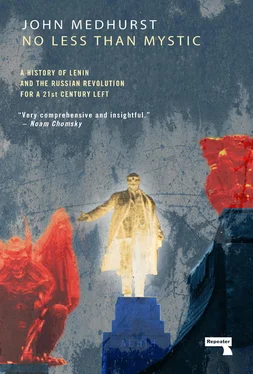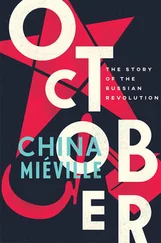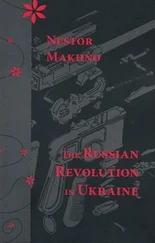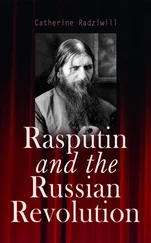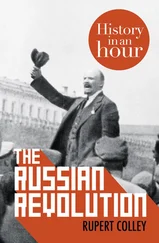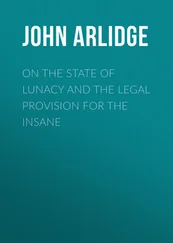The Green rebellions were systematically put down throughout 1921-22 by a mixture of military action, famine, and a slackening-off of peasant discontent as the tax-in-kind policy fed through. Tambov, in particular, went down hard. In April 1921 Tukchachevsky arrived with 100,000 men, a fleet of armoured cars and his own small airforce to drop poison gas on rebel hideouts. By June 50,000 peasants had been rounded up and placed in newly constructed concentration camps. Figes reports estimates that 100,000 peasants were imprisoned or deported while 15,000 were shot. 25By summer the rebellion was effectively over, with famine in the region delivering the literal death blow. Antonov and a small core of rebels evaded capture and continued to harry the authorities until summer 1922 when they were trapped, surrounded and eliminated.
Makhno also fought to the bitter end. After the Red Army’s invasion of Ukraine in 1919 he had formed a temporary alliance with Bolshevik forces to defeat Denikin’s armies. Despite Sovnarcom’s attempt to impose its authority on the Free Territories, that alliance held throughout the summer of 1919. Makhno’s Insurrectionary Army was instrumental in stopping Denikin’s drive towards Moscow and in pushing him back to the Black Sea. At the end of 1919 Makhno was ordered by Trotsky to transfer his forces to the Polish front, an order he refused. The Bolsheviks then turned on the Makhnovists.
A Makhnovist proclamation of June 1920 entitled “Pause! Read! Consider!”, aimed at Red Army soldiers, some of whom were native Ukrainians, attempted to subvert Bolshevik discipline. “They tell you that the Makhnovists are bandits and counter-revolutionaries”, it began, before explaining,
We, the revolutionary insurgent Makhnovists, are also peasants and workers like our brothers in the Red Army. We rose against oppression. We are fighting for a better and brighter life. Our frank ideal is the achievement of a non-authoritarian labourers’ society without parasites and without commissar-bureaucrats. Our immediate goal is the establishment of the free Soviet order, without the authority of the Bolsheviks, without pressure from any party whatsoever.
The proclamation ended, “Comrade! Think about it, who are you with and who are you against? Don’t be a slave–be a man”. 26
Hostilities between the Red and Insurrectionary armies continued until October 1920, when the Bolsheviks again asked Makhno to assist them in throwing back the last White offensive of the Civil War, Wrangel’s drive north to Moscow from the Crimea. Again Makhno fought the Whites and helped defeat Wrangel. His reward was that on 25th November his senior commanders in the Crimea were arrested and shot. Simultaneously Trotsky ordered a mass attack on Gulyai-Polya, which destroyed the core of his army and seized control of the Free Territory.
Makhno himself escaped with a few men and spent the next year wandering the Ukrainian steppes fighting a lastditch guerilla war. Wounded and ill, in 1921 he crossed to Romania. He ended his days working on the production line of the Renault car plant in Paris, where he died of tuberculosis in 1934. Yet some things are not forgotten. In 1953, upon hearing of the death of Stalin, a vast insurrection took place across the camps of the Gulag. It is reported that after seizing control the prisoners of Norilsk camp in the Arctic Circle, 70% of whom were Ukrainians serving the standard 25-year sentence for political prisoners, hoisted the black flag of Nestor Makhno to the top of the flagpole.
The Bolsheviks were lucky in the timing of the peasant rebellions. The food shortages that caused them also prevented them from developing into a unified national movement. Peasants in many regions were simply too weak to battle the Red Army. The great famine of 1921-22 devastated the Volga region and spread to the Urals Basin, the Don, southern Ukraine, Kazakhstan and western Siberia. Its direct cause was a crop failure in 1920 followed by severe draught that reduced the area to a dustbowl. Even then the peasants might have survived from reserve stocks, but these stocks had been taken by the Grain Requisition Squads. There was nothing to fall back on and no government willing or able to direct food to where it was most needed. Desperate peasants tried to escape the wasted regions but the roads were closed. There was no transport to the towns. Whole villages died and were later found empty but for corpses. It is estimated that nearly five million people died of starvation over 1921 and 1922.
Although the NEP era was very different from that of War Communism, one thing remained constant–the privileges to be had from party, especially inner-party, membership. The system of privilege started at the top, with the 5,000 senior Bolsheviks and their families who lived in the Kremlin or the special party hotels, the Metropole and the National, in the centre of Moscow. The hotels had been restored to their pre-war opulence and after 1920 were well-stocked with luxuries that most workers could not afford. The Kremlin had a staff of 2,000 servants and its own shops and restaurants. In Petrograd the party elite lived in the former Astoria hotel, now the First House of the Soviets. Chekists in leather jackets kept the masses away, who could only watch in awe as Zinoviev, the local party boss, went back and forth in his limousine, “with his Chekist bodyguards and a string of assorted prostitutes”. 27This was a side of the struggle he had forgotten to mention at the Halle Congress.
In June 1921 Berkman had occasion to visit the Hotel Luxe in Moscow, where delegates to the Comintern from foreign communist parties were quartered. He recorded that the street outside was lined with Rolls Royces. “The brilliant banquet hall is crowded”, he wrote. “The velvety cushions and bright foliage of the smoking room are restful to the delegates of the western proletariat”. He was allowed to observe the full Congress of the Comintern, marveling at the naivety of newly arrived delegates:
With glowing fervor they dwell on the wondrous achievements of Communism. Like a jagged scalpel their naïve faith tears at my heart where bleeding lie my own high hopes, the hopes of my first days in Russia, deflowered and blighted by the ruthless hand of dictatorship.
After reports of the imprisonment of Mensheviks and anarchists, some foreign delegates began to ask difficult questions. “Some of the Germans, Swedish and Spanish members are perturbed by the general situation”, Berkman recorded on 9th July. “They have been in contact with the actual conditions; they have sensed the spirit of popular discontent and caught a glimpse of the chasm between Communist claims and the reality”. 28
Soviet citizens themselves knew the reality very well, and adapted to it. Once the Civil War was over and the danger of seeing military service had declined, membership of the RCP shot up, from 430,000 at the beginning of 1920 to 600,000 six months later. Lenin sensed what was happening but couldn’t admit what had caused it. “It was absolutely inevitable”, he wrote in June 1919, “that adventurers and other pernicious elements should hitch themselves to the ruling party. There has never been, and never can be, a revolution without that”. In July 1921 he oversaw a purge of about a fifth of the RCP’s members, designed to clear out those who had joined solely out of self-interest. In the long run it made no difference. In April 1922 Lenin approved the creation of a new post at the apex of the party, the General Secretary, to oversee and control the entire party bureaucracy. Over some objections, his preferred candidate, Stalin, was duly appointed.
At the same time Lenin finished, for good and all, the quarrel between the Bolsheviks and the Mensheviks. In Memoirs of a Revolutionary , the anarchist turned Bolshevik Victor Serge recalled of Lenin’s long-standing opponents in 1919:
Читать дальше
